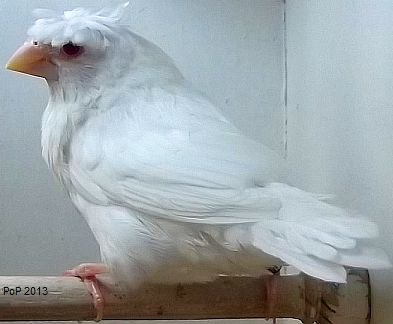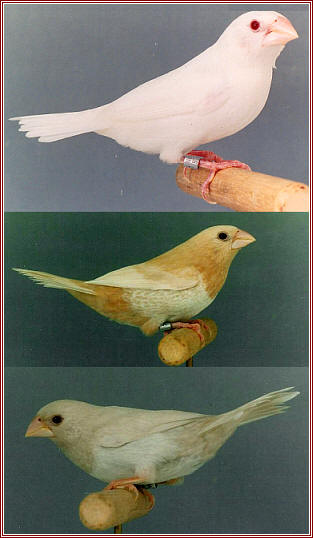

Having been asked to explain on several occasions
the genetics of the "Inos". Here is what I know about these varieties, much
from experience some from discussion with other fanciers.
ALBINOS:
The Albino factor erases all trace of melanin's
from the entire bird, and a pink colour is seen in nails, beak and skin, but
is most noticeable in the eyes, this is due to the skins transparency, so
the blood circulating beneath the skin is seen.
Here in the UK we breed the recessive Albino, to
produce these birds the Albino factor must be present in either Split or
Visual form for it to appear in the youngsters.
The colours used to pair with Albinos to produce
splits are variegated Fawn Dilutes and Variegated Silvers, (these Silvers
being a Chestnut Dilute Variant). In theory any colour can be used to
produce split for Albino birds, in practise the lighter colour varieties
produce better quality colour in the resultant Albinos. The use of dark
birds i.e. Chocolates tends to produce smudges of grey and the White is not
as clean on the Albinos thus produced. From these pairings there can also
appear the occasional Dark Eyed White, these birds are particularly useful
in the production of Good Albinos.
CREMINOS & GREYINOS:
The Cremino is I believe what is described in
other species as a Cinnamon Ino where the brown melanins are not completely
erased from the bird. They are sex-linked in inheritance.
They appear to be a pink eyed diluted Fawn, but
are a separate mutation that is not affected by combination with other
colours, except when combined with the Grey Factor to produce the Greyino.
The first Cremino was discovered in Denmark in
1983 in a nest of Dark Brown Bengalese. It has reached its present
exhibition form due to skilful combination of Dutch birds by fanciers in
Holland & Belgium. The best birds to use in their production are those with
the greatest amounts of melanin, these being the Black Browns (Chocolates),
the aim is to produce well -coloured specimens for exhibition.
The Creminos produced from the lighter varieties
tend to be pale in colour, and not generally good exhibition birds.
I have produced more by accident than design
Creminos that have little if any melanin in the birds, due to accidental
introduction of Cremino into my Red Grey birds in the past, when I knew
little about them. These I believe have been developed further on the
Continent where they now have these sex-linked "Albinos" as a separate
colour variety. It's my belief these birds are still genetically Creminos.
When combined with the Grey Factor the Cremino
gives us the Greyino .
This works in much the same way as when we combine
the Fawn with Grey, by reducing in the offspring the amount of the Red
phaeomelanin and the Black Brown eumelanin to give the Grey colouring to the
feathers. These birds although not hard to produce, take patience as it
takes several generations to combine a Recessive and a sex-linked trait into
one bird.
Summing all this up, know Ino birds are the
recessive Albino, and the Sex-linked Cremino that can also be combined with
Grey to give us the Greyino.

